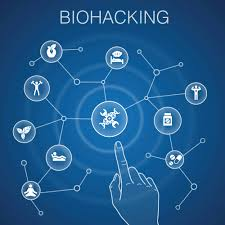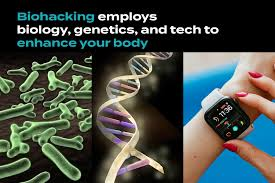BIOHACKING
Biohacking is the practice of making changes to the body to improve health, performance, or well-being. It can involve making lifestyle changes, using technology, or implanting devices in the body.
Lifestyle changes Consuming less refined carbs, Moderating caffeine, Intermittent fasting, Taking cold showers, and Using saunas.
Technology
- Using smartwatches or Fitbits to track sleep and exercise
- Using radiofrequency identification (RFID) implants
Implantation
- Implanting magnets, sensors, or lights into the body
Other terms Amateur biology, DIY biology, and Garage biology.
Biohacking goals
- Improving cognitive function
- Managing weight
- Improving athletic performance
- Extending life
- Having control over health
- Exploring new ideas
- Fixing perceived flaws
Biohacking risks infection, tendon attrition, life-threatening mutations, and pseudo-scientific peddling that does more harm than good.

KEY TECHNOLOGIES:
Biohacking is a personalized process that uses technology and lifestyle changes to improve health. Some technologies used in biohacking include:
- Wearable technology Fitness trackers, sleep monitors, and brainwave-sensing headbands collect health data.
- Cellular metabolism monitoring devices Blood glucose monitoring devices and ketone breath analyzers monitor metabolism.
- Genetic engineering tools CRISPR (Clustered Regularly Interspaced Short Palindromic Repeats) edits genes and proteins.
- Implants Microchips, magnets, and electronics are implanted into the body to enhance senses or capabilities.
Other biohacking techniques include:
- Dietary modifications: Taking supplements, following specific diets, or fasting
- Sleep tracking: Optimizing sleep environments and using supplements like melatonin
- Mindfulness: Meditation, stress management, and other practices
- DIY biology: Sharing biohacking information and techniques with non-experts
- Nutrigenomics: Understanding the relationship between nutrition, health, and the human genome
Biohacking can involve incremental or radical changes to diet, lifestyle, or supplementation. It’s important to be cautious when implementing bio hacks without scientific evidence.
BENEFITS OF BIOHACKING:
In conclusion, biohacking offers a multitude of benefits for individuals seeking to optimize their health and performance. Whether it’s enhancing physical performance, boosting cognitive abilities, or promoting longevity and anti-aging, biohacking provides a platform for experimentation and optimization.
\

CONS OF BIOHACKING:
Genetic biohacking of this sort—experimentation on oneself and others—pose public health risks. These include interventions with poor safety or efficacy; a lack of true informed consent; and the introduction and uptake of unsafe and unproven “therapies” into commerce.
USES:
Technology in biohacking is popular. Wearable devices make it possible to monitor important health factors, such as heart rate, sleep quality and physical activity. These devices can also serve as motivational tools, offering features like goal setting, reminders and progress tracking.
HOW IT WORKS?
Biohacking involves making changes to your body to improve physical or mental health. It includes DIY biology, like intermittent fasting, and less conventional experimental biotechnology, like implanted microchips. Research on biohacking’s benefits and effectiveness is limited but promising.


